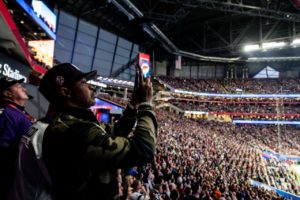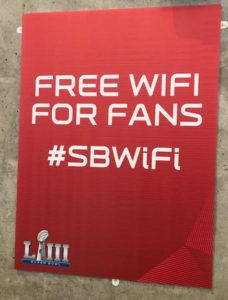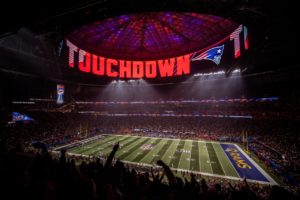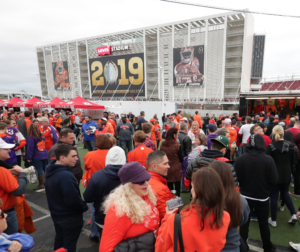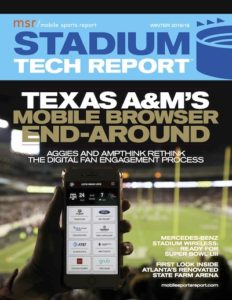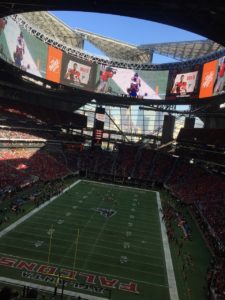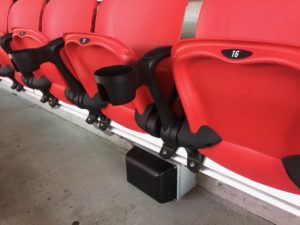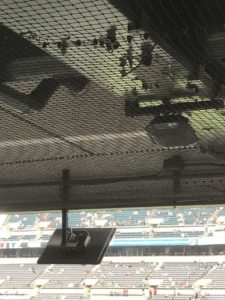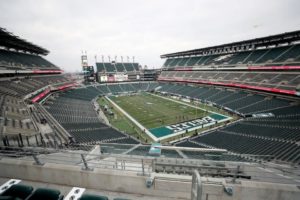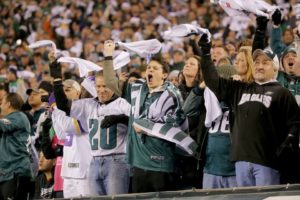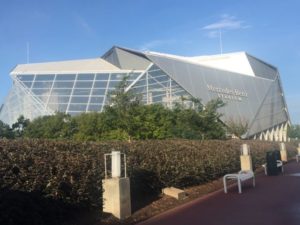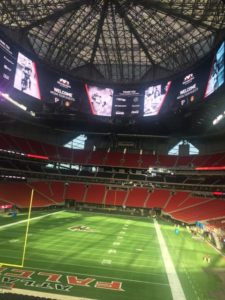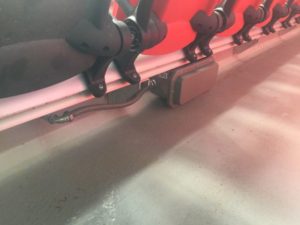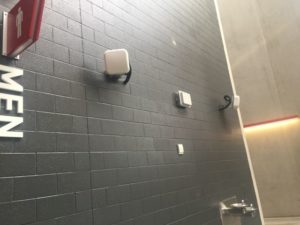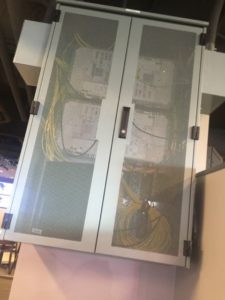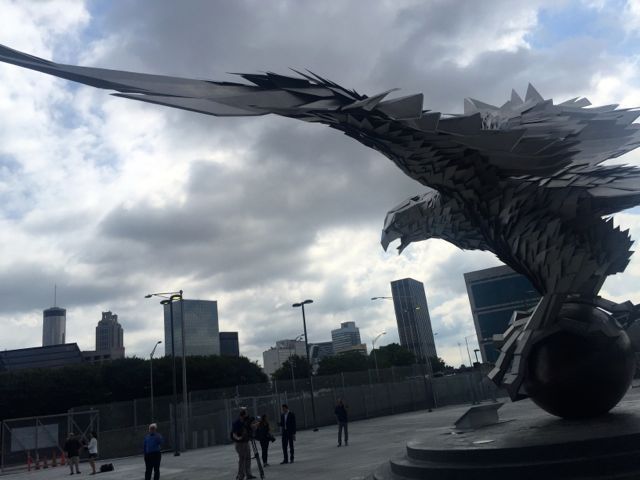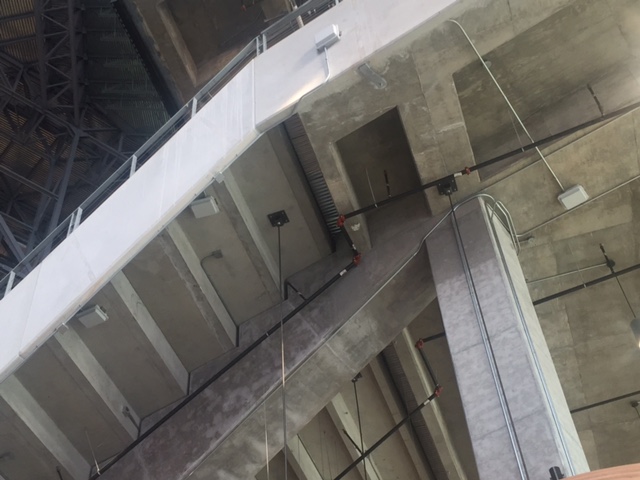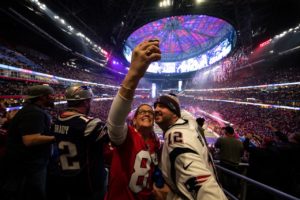
Pats fans celebrate with a selfie at the end of Super Bowl 53. Credit all photos: Mercedes-Benz Stadium (click on any picture for a larger image)
According to official statistics provided by Extreme Networks, new high-water marks were set last Sunday in every category of network measurement, including an amazing 48,845 unique users on the network, a take rate of 69 percent out of the 70,081 who were in attendance to watch the New England Patriots beat the Los Angeles Rams 13-3. The average Wi-Fi data use per connected fan also set a new record, with the per-fan mark of 492.3 megabytes per user eclipsing last year’s mark of 407.4.
While fans might have preferred some more scoring excitement during the game, the lack of any tense moments in network operations was a perfect outcome for Danny Branch, chief information officer for AMB Sports & Entertainment.
“I was ecstatic on how [the network] executed, but honestly it was sort of uneventful, since everything went so well,” said Branch in a phone interview the week after the game. Though network performance and fan usage during some of the big events leading up to the Super Bowl had Branch thinking the Wi-Fi total number might creep near the 20-terabyte range, the early network use on game day gave Branch a clue that the final number might be even higher.
“When I saw the initial numbers that said we did 10 [terabytes] before kickoff we didn’t know where it would end,” Branch said. “When we were watching the numbers near the end of the game, we were just laughing.”
Aruba APs and AmpThink design shine
Editor’s note: This report is from our latest STADIUM TECH REPORT, an in-depth look at successful deployments of stadium technology. Included with this report is a profile of the new Wi-Fi and DAS networks being planned for the University of Colorado, as well as a profile of Wi-Fi at Little Caesars Arena in Detroit! DOWNLOAD YOUR FREE COPY now!
With some 1,800 APs installed inside Mercedes-Benz Stadium — with most of the bowl seating APs located underneath the seats — the Wi-Fi gear from Aruba, a Hewlett Packard Enterprise company, in a design from AmpThink, also saw a peak throughput rate of 13.06 Gbps, seen at halftime. The peak number of concurrent network users, 30,605, also took place during the halftime show, which featured the band Maroon 5 (whose show played to mixed reviews).Extreme Networks, which provides Wi-Fi analysis in a sponsorship deal with the NFL, had a great list of specific details from the event. Here are some of the top-line stats:
Need proof that people still watch the game? Out of the 24.05 TB total, Extreme said 9.99 TB of the traffic took place before the kickoff, followed by 11.11 TB during the game and halftime, and another 2.95 TB after the game concluded.
On the most-used apps side, Extreme said the most-used social apps were, in order of usage, Facebook, Instagram, Twitter, Snapchat and Bitmoji; on the streaming side, the most-used apps were iTunes, YouTube, Airplay, Spotify and Netflix. The most-used sporting apps by fans at the game were, in order, ESPN, NFL, the Super Bowl LIII Fan Mobile Pass (the official app for the game), CBS Sports (which broadcast the game live) and Bleacher Report.
Did Verizon’s offload spike the total?
While Super Bowl Wi-Fi traffic has grown significantly each year since we started reporting the statistics, one reason for the bigger leap this year may have been due to the fact that Verizon Wireless used its sponsorship relationship with the NFL to acquire its own SSID on the Mercedes-Benz Stadium Wi-Fi network.
According to Andrea Caldini, Verizon vice president for networking engineering in the Eastern U.S., Verizon had “autoconnect in play,” which meant that any Verizon customer with Wi-Fi active on their devices would be switched over to Wi-Fi when inside the stadium.“It’s going to be a good offload for us,” said Caldini in a phone interview ahead of the Super Bowl. While Verizon claimed week to have seen “record cellular traffic” as well during Super Bowl Sunday, a spokesperson said Verizon will no longer release such statistics from the game.
According to Branch, the NFL helped fans find the Wi-Fi network with additional physical signage that was put up just for the Super Bowl, in addition to rotating messages on the digital display screens around the stadium.
“The venue was well signed, we really liked what they [the NFL] did,” Branch said. Branch said the league also promoted the Wi-Fi link throughout the week, with a common ID at all the related Super Bowl activity venues, something that may have helped fans get connected on game day.
No issues with the DAS
One of the parts of the wireless mix at Mercedes-Benz Stadium, the cellular distributed antenna system, was under scrutiny after a lawsuit emerged last fall under which technology supplier IBM sued Corning over what IBM said was faulty installation. While Corning has disputed the claims, over the past year IBM, the Falcons and the NFL all said they got the DAS in working order, and according to Branch “all the carriers were pleased” with its operation during the Super Bowl.
According to Branch, the Falcons saw 12.1 TB of traffic on the in-stadium DAS on Super Bowl Sunday, including some traffic that went through the Matsing Ball antennas. Branch said the two Matsing Balls, which hang from the rafters around the Halo Board video screen, were turned back on to assist with wireless traffic on the field during the postgame awards ceremony.Overall, the record day of Wi-Fi traffic left Branch and his team confident their infrastructure is ready to support the wireless demands of more big events into the future, including next year’s NCAA men’s Final Four.
“Until you’ve taken the car around the track that fast, you don’t really know how it will perform,” Branch said. “But so much work was done beforehand, it’s great to see that it all paid off.”
